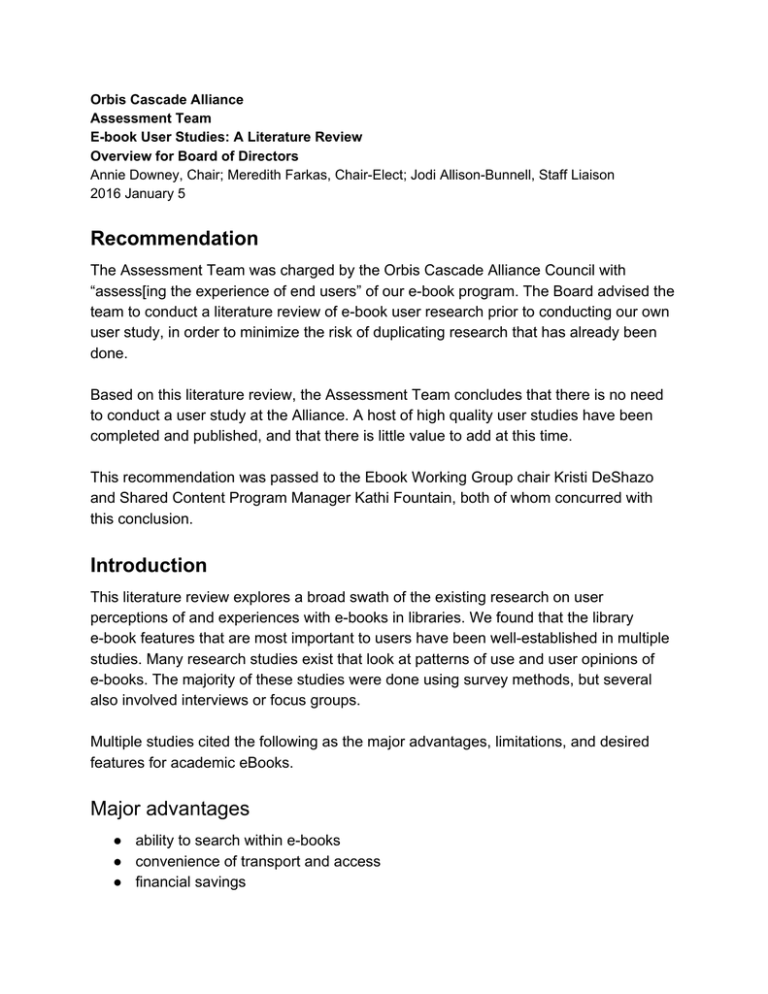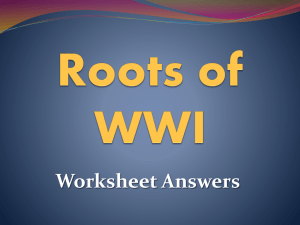Recommendation Introduction Major advantages
advertisement

Orbis Cascade Alliance Assessment Team E­book User Studies: A Literature Review Overview for Board of Directors Annie Downey, Chair; Meredith Farkas, Chair­Elect; Jodi Allison­Bunnell, Staff Liaison 2016 January 5 Recommendation The Assessment Team was charged by the Orbis Cascade Alliance Council with “assess[ing the experience of end users” of our e­book program. The Board advised the team to conduct a literature review of e­book user research prior to conducting our own user study, in order to minimize the risk of duplicating research that has already been done. Based on this literature review, the Assessment Team concludes that there is no need to conduct a user study at the Alliance. A host of high quality user studies have been completed and published, and that there is little value to add at this time. This recommendation was passed to the Ebook Working Group chair Kristi DeShazo and Shared Content Program Manager Kathi Fountain, both of whom concurred with this conclusion. Introduction This literature review explores a broad swath of the existing research on user perceptions of and experiences with e­books in libraries. We found that the library e­book features that are most important to users have been well­established in multiple studies. Many research studies exist that look at patterns of use and user opinions of e­books. The majority of these studies were done using survey methods, but several also involved interviews or focus groups. Multiple studies cited the following as the major advantages, limitations, and desired features for academic eBooks. Major advantages ● ability to search within e­books ● convenience of transport and access ● financial savings ● annotation and highlighting ● easily findable through catalog and Google Major limitations ● dislike reading long documents (like books) on a screen; prefer the feel and experience of the physical book ● need better annotation tools ● limited download options ● need to download proprietary software ● platforms do not meet common user expectations Desired features ● ● ● ● ● ● ● ● no DRM limitations to downloading and printing searching within and across ebooks print individual pages citation tools note taking tools option to read offline (download capabilities) multiple user access accessibility for users with disabilities Useful Tools for the Alliance: Optimizing Access and Usability In addition to the above lists, we also identified three resources that may be of particular use to the Alliance. Access First, Roesnita and Zainab’s Ebook Use Model (figure 1 below) could be useful to the Alliance in determining whether or not patrons are likely to use the e­books in our consortial collection. It includes the cognitive factors, access factors, functional factors, and technology competencies that influence if a user will choose to use e­books. This model is largely focused on access issues so it will help the Alliance determine if our access options are optimal for users and encourage the use of our collection. 1 Figure 1: Roesnita and Zainab’s Ebook Use Model Usability The second and third sources focus on usability after users have accessed an e­book and are chapters from the recently published Academic E­Books: Publishers, Librarians, and Users edited by Ward, Freeman, and Nixon. Because most of the features that users desire are platform­dependent, these well researched and written pieces may fulfill the Alliance need to better understand why users choose to use or leave e­books once they discover them. In “Library E­Book Platforms are Broken: Let’s Fix Them,” Thomas and Chilton argue that “e­books promise users convenience and accessibility, but library e­book platforms 1 Roesnita, Ismail, and A. N. Zainab. “The Pattern of E­Book Use amongst Undergraduates an Malaysia: A Case of to Know Is to Use.” arXiv Preprint arXiv:1301.5400 , 2013. http://arxiv.org/abs/1301.5400. contain so many barriers to use and access that patrons often turn away in frustration.” The authors unpack the many barriers and frustrations that users encounter and propose solutions for how platforms could be improved. In “Platform Diving: A Day in the Life of an Academic E­book Provider,” Nardini analyzes 15,954 e­book sessions started on a single day on the MyiLibrary academic e­book platform. While this is not the platform used by the Alliance, the issues identified are relevant to all academic e­book platforms. Possible Areas of Inquiry We discovered two things that have not been investigated as much and might be possible areas of future inquiry: 1. How access mechanisms for library e­books (discovery systems and the e­book platforms themselves) facilitate or hinder library patrons in accessing e­books 2. What causes patrons to quickly leave an e­book they decided to access The first item was suggested by JISC (Joint Information Systems Committee) in their study “Establishing methods for future students on the impact of e­books,” in which they recommend observational and “think­aloud” approaches to analyzing user behavior and understanding around access mechanisms. The latter idea was suggested both by our own significant eBook drop­off statistics and by an additional JISC study, which found that only 5% of student and 7% of faculty e­book users read an e­book in its entirety. Better understanding how and for what our patrons use e­books could help guide future consortial eBook strategies. However, in light of a rapidly changing environment and proposed changes in the Alliance’s Ebook program, the group stands by its recommendation that the Alliance pursue no user studies at this time. Sources Available on request; will be posted to the Alliance website in February.




